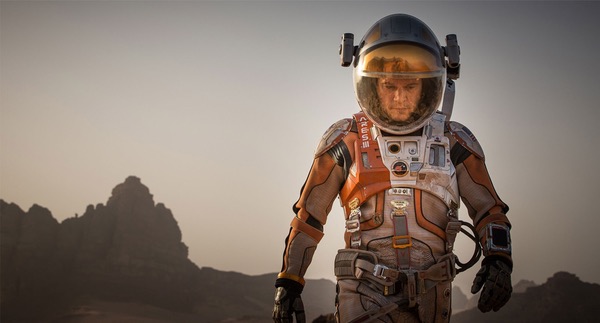The Martian messageby Eric R. Sterner
|
| Sadly, if the space community seeks to turn The Martian into a commercial for sending people to Mars, we will fail miserably. |
Surely, several interests want to capitalize on the melding of film and speculative reality. Damon recently visited the Jet Propulsion Laboratory, where he talked about his role, and NASA’s website proudly uses the opportunity to explain the real NASA-developed technologies portrayed in the movie. It can only do a space advocate’s heart good when Hollywood seems to discover the same sense of excitement in space that we see and experience every day.
Sadly, if the space community seeks to turn The Martian into a commercial for sending people to Mars, we will fail miserably. The 2000 movie Castaway was nominated for multiple awards, including an Academy Award for Tom Hanks. It did not increase public support for sending people to deserted islands. Neither will The Martian bring them closer to Mars.
We have witnessed this story, if not the movie, before. In 1995, Universal Pictures released Apollo 13, directed by Ron Howard and starring Tom Hanks, Gary Sinise, Bill Paxton, Kevin Bacon, Ed Harris, and Kathleen Quinlan. The film went on to receive nine Academy Award nominations, winning two. In making Apollo 13, the space bug bit at least two of the actors. Hanks subsequently produced the HBO series, From the Earth to the Moon, and Sinise donned another space suit for Mission to Mars. Moreover, Hollywood took notice of Apollo 13’s financial and dramatic success. In addition to the aforementioned productions, it released Red Planet, another movie about an astronaut stranded on Mars starring Val Kilmer; Armageddon, in which Bruce Willis led a team of deep core oil drillers to an asteroid; Deep Impact, another asteroid movie starring Robert Duvall; and Space Cowboys, a Clint Eastwood film about a bunch of aging astronauts rescuing a satellite. Of course, we cannot forget 2013’s Gravity, about an astronaut played by Sandra Bullock stranded in low Earth orbit (seven Oscar wins), or 2014’s Interstellar, about an astronaut stranded in another dimension (one Oscar win.)
The films that succeeded worked because their stories revolved around human drama, not because they were set in space. Depending in part on each movie’s technical credibility, star power, general appeal, and marketing plans, at least some elements of the space community sought to use them to advocate space exploration. Yet, we’re no closer to the Moon, Mars, or any other destination. The Martian will not change that.
Instead of seizing upon the movie as one more opportunity to advocate a particular space mission or vision for the future, the space community should view it as an opportunity to connect people to the process of solving scientific and technical problems and to reveal the human drama that lies at the heart of exploration, whether that exploration occurs in the human mind and heart (think last year’s Theory of Everything or The Imitation Game) or in sending people into space and getting them home.
| People appreciate space activity when they can relate to it and that’s when they start to care about it. Abstract visions of future missions favored by one group or another simply will not move the needle on public support for space exploration. |
In the novel, Watney is a botanist and mechanical engineer who also must perform as a chemist, mechanic, communications specialist, seamstress, lab technician, and endurance driver. Weir is careful to show, as accurately as possible in a fictional account, how each of these roles draws on certain problem-solving skills and how human ingenuity can lead to great things. The excitement and drama come from Watney’s struggle to overcome the challenges that life sends him. That lesson is important and universal, whether one is surviving on Mars or making potable water available to refugees from natural and human-made disasters. Space is unique because it so frequently demands that we exercise all these skills all at once. It demonstrates for everyone to see the meaning of Kennedy’s insistence that we go to the Moon because it was hard, because it challenged us. It reminds us amidst the wreckage we so often create in the world that the human animal is capable of remarkable things. And, it’s a darn good yarn.
Regardless of those things that divide us, we can all look at the stars and wonder. We have that in common. The New Horizons mission to Pluto generated worldwide headlines and considerable excitement outside the space community because it represented a human accomplishment—visiting the last of planets of the solar system. Alan Stern, the principal investigator, became a media celebrity of sorts. Similarly, NASA’s Mars rovers ginned up excitement in schools around the world, as we anthropomorphized the small vehicles and the difficulties they overcame. (Of course, they did not overcome those difficulties; operations teams back on Earth did.) International Space Station Commander Chris Hadfield managed to humanize his experience simply by embracing social media and utilizing his singing voice. As of this writing, his cover of David Bowie’s “Space Oddity” has over 26 million views on YouTube. People appreciate space activity when they can relate to it and that’s when they start to care about it. Abstract visions of future missions favored by one group or another simply will not move the needle on public support for space exploration.
If the new movie generates interest in space, then we would do well to tell more stories, to keep connecting individual experiences to a greater purpose and demonstrate how people innovate to overcome the obstacles fate sends their way. Space advocacy means showing how the exploration and use of space fits in to the broader human experience and how it enriches that tale. The Martian is an opportunity to humanize our approach to space, to help moviegoers appreciate the stories that are already there and those yet to be told.
